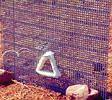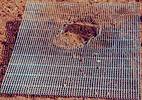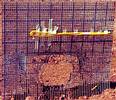
One could be excused for thinking that a fence is just a fence and that the most consideration that could be given to such an item would be what it is made of. But the science of wire manufacture is complex and dynamic in itself.
It is the wire that goes into high security fencing systems that is ofparamount importance because to have a fence that looks robust and one that bears imposingly on the landscape is not a sufficient deterrent to the determined and hardened criminal.
While drawing upon the world's largest independent steel manufacturer's international might and resource, the local joint venture company between Bekaert and the former SA distributor for Bekaert products, Bastion Wire, Bekaert Bastion has taken the testing process that bit further in South Africa.
Semi-bomb and bullet-resistant
Bekaert Bastion high security mesh is semi-bomb and bullet-resistant and has been exhaustively tested by SA Police Services. The high security mesh is virtually bomb-proof due to a minimum of 80% weld strength of high tensile wires.

Johann Meiring, SA Police Services captain and acting commanding officer of Bomb Disposal and Research, conducted three explosion tests on Bekaert Bastion's security mesh, using military and commercial explosives. The first test used 450 grams of PE4 plastic explosives, which were divided and placed in triangular formation to cover the largest area. A second test used a double layer of detonating fuse (with a force of 40 g/m) approximately 600 cm long, which was placed on the mesh and detonated.

The third test involved approximately 500 g of emulsion (ammonium nitrate) explosives that were placed on the mesh and detonated. After the third explosion, there was an opening in the mesh of approximately 45 cm x 30 cm. It should be remembered that the mesh was exposed to a total of three explosions and an undamaged section of mesh would have suffered damage to a lesser extent.
Meiring explains: "The openings in the mesh caused by the explosions were large enough for an arm or leg to pass through but the mesh was still strong enough not to be prised open any further. The appearance of the mesh wire and the way it is welded together dissipates the full energy of the blast. Compared to previous tests conducted by this unit on a variety of other security mesh products, the Bekaert Bastion product was very impressive."


Coating technologies put to the test
Bekeart Bastion asked the CSIR's Advanced Engineering and Testing Services Programme to compare the corrosion behaviour of two types of zinc-coated wire mesh using a standard salt spray test. One of the wire mesh samples was coated with a hot-dipped zinc coating containing 5% aluminium and 95% zinc, known as Bezinal - the Bekaert patented wire coating. The other mesh sample was hot-dipped galvanised mesh.
The tests revealed that the hot-dipped galvanised sample started to show red rust after approximately 120 hours of exposure, while the Bezinal coated sample showed red rust after approximately 336 hours of exposure. This demonstrates that the Bezinal coated sample took approximately 2,8 times longer than the hot-dipped galvanised sample to show the same degree of red rust staining.
Further analysis of the coating thickness after 1000 hours of salt spray testing indicated that the Bezinal coating has remained relatively intact. The average coating thickness was measured as 37,5 per metre. No significant loss in coating thickness occurred on the Bezinal coated samples.
Managing director of Bekaert Bastion, Michael Rodenburg, adds: "As security is critically important, we cannot afford to be slack about our choices in making our commercial and industrial property and our utilities as impenetrable as possible. The fact that our products are tested so rigorously and can withstand the most determined attacks, demonstrates that we can safeguard our clients against the very worst attempts at break-ins. Add to this the fact that we offer systems persevere particularly well in harsh weather conditions prevail - means that we provide lasting strength. This has to be what proper security is all about."
For more information contact Bekaert Bastion, 021 905 4535 or [email protected]

© Technews Publishing (Pty) Ltd. | All Rights Reserved.